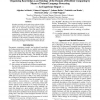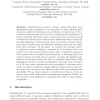217 search results - page 6 / 44 » Filling the gap between biology and computer science |
CRYPTO
2010
Springer
13 years 8 months ago
2010
Springer
Multiparty computation protocols have been known for more than twenty years now, but due to their lack of efficiency their use is still limited in real-world applications: the goal...
FLAIRS
2009
13 years 5 months ago
2009
Scientists typically need to take a large volume of information into account in order to deal with re-occurring tasks such as inspecting proceedings, finding related work, or revi...
HICSS
2003
IEEE
14 years 23 days ago
2003
IEEE
This paper describes the design and evaluation of COLER, a computer mediated learning environment that includes a software coach to help students collaborate while solving Entity ...
RECOMB
2004
Springer
14 years 7 months ago
2004
Springer
Identifying gene clusters, genomic regions that share local similarities in gene organization, is a prerequisite for many different types of genomic analyses, including operon pred...
CHI
2002
ACM
14 years 7 months ago
2002
ACM
In this paper, we present SpiraClock, a new visualization technique for nearby events. SpiraClock fills a gap between static calendar displays and pop-up reminders by giving the u...


